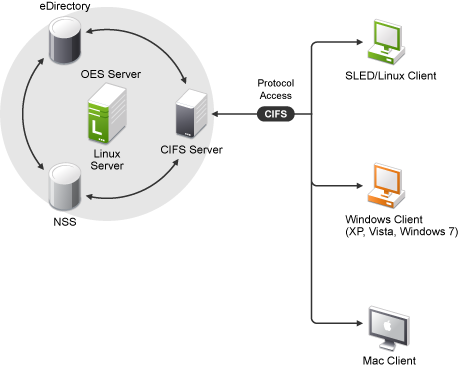1.1 Understanding CIFS
The Common Internet File System (CIFS), also known as Server Message Block (SMB), is an application-layer network protocol used for providing shared access to files on a Local Area Network (LAN). It relies on NetBIOS over TCP (NBT) for reliable transport. Although file sharing is the primary purpose of CIFS, there are other functions that CIFS is commonly associated with. Some of them include service announcements, name resolution, user authentication, authorization, and browsing for other CIFS servers in the network.
Novell CIFS runs on the Open Enterprise Server (OES) 11 SP3 server, uses NetIQ eDirectory services for user authentication, and allows Windows, Linux, and Mac client users to access the server data files or other shared resources in one of the following ways:
-
For Windows, through the Network Neighborhood or My Network, Windows Explorer, and mapped drives from Windows workstations.
-
For Linux, through an SMB client from Linux desktops.
Figure 1-1 Novell CIFS Conceptual Overview

Novell CIFS enables Windows, Linux, and Mac client workstations to create, copy, delete, move, save, and open files on an OES 11 SP3 server. CIFS allows read and write access from multiple client systems simultaneously. All these various file operations and sharing of resources on a network are managed from a CIFS server.